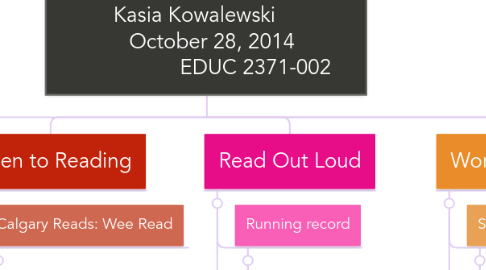
1. Read to Self
1.1. Early morning silent reading
1.1.1. Grades K-6
1.1.2. Literacy learning
1.1.3. Students come into the classroom first thing in the morning and wind-down with silent reading at their desks. A bucket of books can be put on their table or desk section or they can bring their own book from home. This will get students into the routine of daily reading.
1.2. Read partners work
1.2.1. Grades 1-6
1.2.2. Work sharing
1.2.3. After a literary assignment or journal entry desk partners or friends can trade their work and read their friends. This can develop new ideas and discussions. between the partners.
2. Read Out Loud
2.1. Running record
2.1.1. Grades 1-6
2.1.2. Reading evaluation
2.1.3. Students are evaluated on their reading by participating in a running record. A recorder notifies when students stumble upon words or make a mistake. This determines the student's reading level.
2.2. Classroom Spelling Bee
2.2.1. Grades 1-6
2.2.2. Verbal word game
2.2.3. Students are given a list of words to study each month and at the end of the month a fun Spelling Bee is held for the class. It could be made into a party with snacks and prizes for the top three spellers.
3. Writing
3.1. Daily journal
3.1.1. Grades 1-6
3.1.2. Personal reflection
3.1.3. Students are asked to write a journal on either a question posted by the teacher or their own choice. Adding illustrations to the journal will personalize it to each student and to each journal entry.
3.2. Book report
3.2.1. Grades 3-6
3.2.2. Literacy and reading comprehension
3.2.3. Students are asked to write a book report with illustrations on either an assigned classroom novel or a book of their choice. This will aid students in practicing their reading comprehenssion.
4. Listen to Reading
4.1. Calgary Reads: Wee Read
4.1.1. Grades K-2
4.1.2. Reading comprehension
4.1.3. Students are brought out of the classroom two at a time and are read to by a Calgary Reads volunteer. Post reading, there are discussions on different aspects of the story.
4.2. Classroom story time
4.2.1. Grade K-3
4.2.2. Literacy activity
4.2.3. The entire class listens to the teacher read a story. The story picked could have a theme relevant to the time of year or situations in the classroom (Christmas, Halloween, someone has chicken pox, a student is becoming a big brother/sister, etc.).
5. Word Work
5.1. Scrabble time
5.1.1. Grades 4-6
5.1.2. Word game
5.1.3. During open centres in a classroom, students can participate in a game of scrabble. There could be a theme picked each day (related to what was taught previously in the day) to add variety to the traditional game and to review previous material.
5.2. Word searches
5.2.1. Grades 1-6
5.2.2. Word game
5.2.3. Students have the opportunity to exercise their brains and practice their spelling skills. Word searches can be themed to what is relevant to the classroom studies or to the time of the year.
